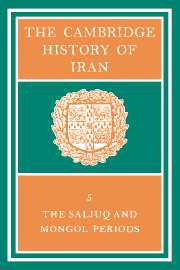Crossref Citations
This Book has been
cited by the following publications. This list is generated based on data provided by Crossref.
Meredith, Colin
1971.
Early Qajar Administration: An Analysis of its Development and Functions.
Iranian Studies,
Vol. 4,
Issue. 2-3,
p.
59.
Cahen, Claude
1977.
Les peuples musulmans dans l’histoire médiévale.
Amitai-Preiss, Reuven
1991.
Evidence for the Early Use of the Title īlkhān among the Mongols.
Journal of the Royal Asiatic Society,
Vol. 1,
Issue. 3,
p.
353.
Calderini, Simonetta
1993.
‘Ālam al-dīn in Ismā‘īlism: world of obedience or world of immobility?.
Bulletin of the School of Oriental and African Studies,
Vol. 56,
Issue. 3,
p.
459.
Chekeni, Ahmad Reza
1993.
Poet as educator.
International Journal of Lifelong Education,
Vol. 12,
Issue. 3,
p.
205.
Shukurov, Rustam
1994.
Between peace and hostility: Trebizond and the Pontic Turkish periphery in the Fourteenth century.
Mediterranean Historical Review,
Vol. 9,
Issue. 1,
p.
20.
Amitai-Preiss, Reuven
1996.
Ghazan, Islam and Mongol tradition: a view from the Mamlūk sultanate.
Bulletin of the School of Oriental and African Studies,
Vol. 59,
Issue. 1,
p.
1.
Foran, John
1996.
Modes of production in pre‐capitalist Iran: Reflections on Abbas Vali'spre‐capitalist Iran: A theoretical history.
Critique: Critical Middle Eastern Studies,
Vol. 5,
Issue. 8,
p.
95.
1999.
The New Cambridge Medieval History.
p.
835.
Jackson, Peter
1999.
The New Cambridge Medieval History.
p.
701.
Brett, Michael
2000.
The New Cambridge History of Islam.
p.
547.
Fierro, Maribel
2000.
The New Cambridge History of Islam.
Manz, Beatrice Forbes
2000.
The New Cambridge History of Islam.
p.
128.
Adhami, Siamak
2002.
Selected Onomastic Writings, Rüdiger Schmitt, edited by Winfried Breidbach and Philip Huyse, New York: Bibliotheca Persica Press, 2000, ISBN: 0–933273–42–8, 303pp., $48.00 (Mostly in German)..
Iranian Studies,
Vol. 35,
Issue. 1-3,
p.
197.
Afkhami, Amir Arsalan
2002.
Discours sur l'oeil, Ismaᶜil Gurgani, trans, and ed. B. Thierry de Crussol des Epesse, Tehran: L'Institut Français de Recherche en Iran and Presses Universitaires d'Iran, 1998, ISBN: 2–909961–20–6, 296 pp..
Iranian Studies,
Vol. 35,
Issue. 1-3,
p.
205.
Brett, Michael
2004.
The New Cambridge Medieval History.
p.
675.
RAPHAEL, KATE
2009.
Mongol Siege Warfare on the Banks of the Euphrates and the Question of Gunpowder (1260–1312).
Journal of the Royal Asiatic Society,
Vol. 19,
Issue. 3,
p.
355.
Fleet, Kate
2009.
The Cambridge History of Turkey.
Melville, Charles
2009.
The Cambridge History of Turkey.
p.
51.
Shepard, Jonathan
2009.
The Cambridge History of the Byzantine Empire c.500–1492.



